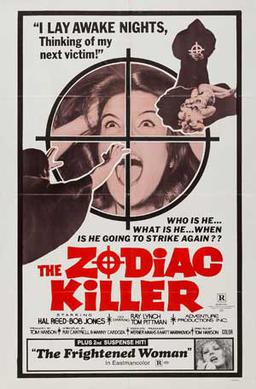
What price proximity? That’s what made me watch the almost-unknown cult film The Zodiac Killer. It’s based on a true story, about a real crime spree by a real serial killer calling himself The Zodiac, who terrorized northern California circa 1969. But what piqued my cinematic interest was that the film came out in 1971, almost right after these crimes happened. Talk about ripped from the headlines. How timelier, how more “there,” could a film get? Or, on a dingier note—how more opportunistic?
The real-life Zodiac killer murdered (viciously) at least five people, probably killed many others, and sent a series of horrible letters to several San Francisco newspapers, in which he bragged about his killings, warned he would kill more, and included pages of a weird cipher for decoding (some to this day not yet solved). Occurring right at the end of the 1960s, the Zodiac murders, like the Manson killings, have accrued to themselves an almost too symbolic, death-of-innocence aura, forever tainting what was meant to be the Peace and Love generation. As the bloodily apt close to a decade marked, almost yearly, by wars, riots, drugs, assassinations, government-sanctioned brutality, and the permanent upheaval of what were once thought of as stable ‘American’ values, their remembered effect is like a bad acid trip from which we can’t recover. Fate’s Wheel had taken us on a downward turn and, from today’s perspective, I’m not sure we’ve been able to climb back up.
So, of course there had to be a movie about it. And this crude, clumsy, almost gleefully venal 1971 flick might just be what the Zodiac deserves.
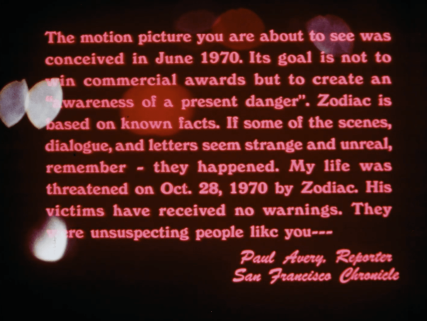
The film is pure, dictionary-defined Exploitation—what the Oxford reference describes as “A film designed by its producers to ‘exploit’…the notoriety of certain sensational current events and trends.” Starting off with a title card (supposedly penned by Paul Avery, a San Francisco Chronicle reporter who covered the case) warning us the film is meant “to create ‘an awareness of a present danger,’” it plunges right in with a scene of a cop in a police car—reading Sinclair Lewis’s It Can’t Happen Here—being plugged by an unseen killer. The killer’s gun-gripping hand thrusts itself into the frame, there’s a swift cut to a blazing gun blast, then a cut back to the cop keeling over, the book flipping like a somersaulting gymnast who’s missed the mat. That’s not just a book being overturned, that’s Law and Order itself—as well as Truth, Justice, The American Way, God, Country, Mom and Apple Pie, you name it. It not only can happen here; it just did.
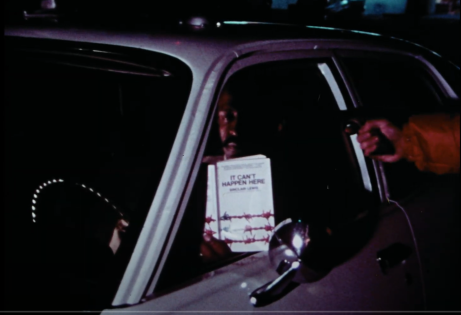
The film’s warning doesn’t pull its punches, at least at the start. “Why don’t you idiots ever learn?”, the killer’s offscreen voice demands, “Don’t you know people like me exist?” The film wants to make sure we do. Its language is blunt and profane, its killings are portrayed graphically (especially a double stabbing of a couple sunbathing on a beach—be warned), its depicted attitudes, particularly those expressed about women—labelled, non-stop, as pigs, bitches, or tramps—are by today’s standards unbelievable, but also believable in that many men did think like this (and many still do). Were these attitudes those of the film’s director, Tom Hanson? Was this his way of reflecting that era’s culture? Was it an attempt to rile audiences? On that last point, Hanson succeeds; a viewing leaves a sour taste in the mouth and a feeling of having spent the film’s 86-minute running time in a public bathroom during rush hour. You don’t feel any too clean afterwards.
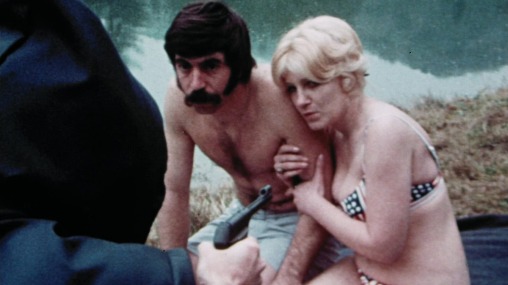
Yet the film fascinates. How could it not? Not only has it got that headline-ripping aura, as in a 1930s Warner Bros’ B-flick, it’s also got a time-capsule quality, of fragments of life recaptured and re-lived before us. Shot on location (I assume in San Francisco), the film gives us scenes of (now oddly quaint) city architecture, signs, and interiors, as well as that grimy, lived-in feel of trodden streets and sidewalks. But it also presents a society caught on the fly, recorded in everyday acts of living. We see how people dressed, talked, presented themselves; how their gestures, motions, their very bodies unconsciously inhabited their time and space. And we watch with that eerie sense that most of these people on camera are probably no longer alive, that what we’re watching, in color and motion, is the technological equivalent of a ghost.
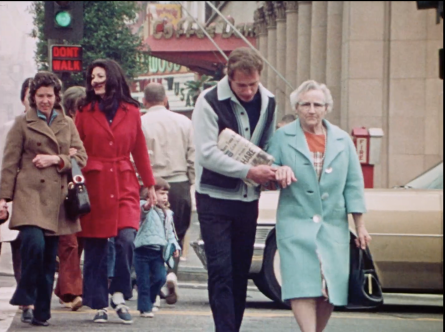
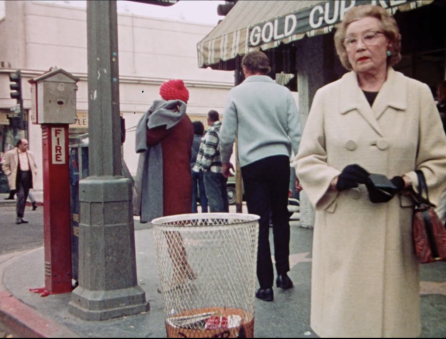
Otherwise, the film disappoints. It’s a work of bare-minimum professionalism, as if scraped together with funds from family and friends, who then doubled as actors and crew. The film stock is washed out and badly lit; the pacing is non-existent; close-ups are shoved in at odd moments; and actors clunkily speak their clunky lines. The story also meanders with bizarre red-herring subplots, such as one about a foul-tempered truck driver who vainly poses as a business executive with the aid of a bad wig and a polyester suit. There’s no reason for this character (was the actor a major donor?), and the plot drags whenever he appears. But the film also supplies a ‘true’ killer, a character written, and acted, with such banal weirdness, you lose interest in him as you watch. Which seems the film’s point; as its closing narration tells us, our slayer is still loose and at large—“me and a lotta guys like me.” He could be anyone out there, and we, the law-abiding public, can’t—or won’t—do anything about it.

The movie does depict the Zodiac’s four attributed assaults (on three couples and a lone cab driver), but it adds a lot of other, non-historical murders, a means, I’m guessing, of jolting flagging attention spans (as if four attacks aren’t enough). A standout has the Zodiac slamming down a car hood on an unsuspecting victim, then bouncing up and down on it like a kid on a trampoline. No doubt, it’s meant to shock and appall, although it’s so over the top, your reaction will more likely be nervous giggles. Oddly, the film’s most intense, horrifying scene is its most static—that of a newspaper editor, after opening a mysterious envelope, reading aloud its accompanying letter to the police over the phone. The scene’s nothing more than a long take on an actor’s face as he talks, but what makes it horrible is that the words he’s speaking are those the real Zodiac wrote, from his real letters, with real dates and details. As I watched and listened, I sensed within me something akin to what that real editor must have felt—a mounting horror, and realization, that this was the casual, cold-blooded confession of an actual killer.
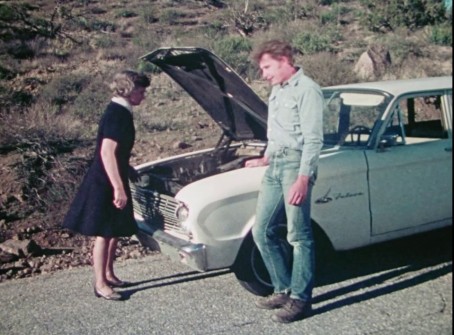
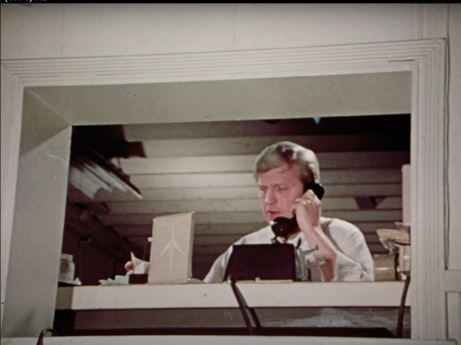
Had the film, as with this telephone scene, stuck to its awful, close-in-time facts, had it stripped itself down to the bare, criminal reality, it might have been something memorable—something stark and ice-cold, shredding our nerves with its, and our, real-life case knowledge. But the film’s very conception seemed impregnated with the exploitative urge. Per Richard Whitaker, Hanson supposedly envisaged his film as a (admittedly “deranged”) plan to entice the real Zodiac to a theater and thereby flush him out. You can already see the screaming headlines—See The Film That Caught A Killer!—but, not surprisingly, no killer was ever caught (although, per IMDB, Hanson claimed a man who resembled the Zodiac police sketch did attend one show…). More likely, the filmmakers were playing not on the Zodiac’s curiosity but on that of their audiences, by adding another level of sleaze to a case that seemed already too ripe for exploitation gimmickry.
Yet despite the flaws and gimmicks, despite its sleaze, cheapness, and overall shoddiness, The Zodiac Killer is a film not easily shaken off. It’s nothing like the big-budget 2007 film Zodiac, which, though elegantly made, seems too distant, too smooth and art-housey, to dive deep into the vile core of the events it depicts. Rather, as that essential guide to lowbrow cinema, The Psychotronic Video Guide, notes, the 1971 film is “actually pretty disturbing and effective.” Maybe because it’s so cruddy. Sure, it’s been dumbed down to the lowest denominator, yet it’s got that lowdown, grindhouse feel, of being in touch with something basic, ugly, and real, about crime, criminals, and violence. Which, frankly, is what a film about the monstrous Zodiac should be like.
Maybe you really hadda be there.
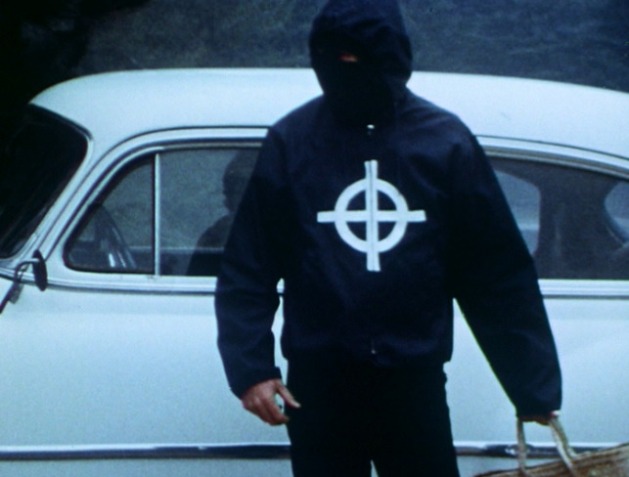
Bonus Clip: Here’s a (R-rated) trailer for The Zodiac Killer—presented, appropriately, by Something Weird Video:
You can watch a complete print of 1971’s The Zodiac Killer on YouTube here. (It’s also available for free on Tubi, if you have a subscription.) Content note: the film has a deserved R rating, and can still shock, even in today’s deranged times…





Brian Schuck
/ March 4, 2024I was about half way through your review when it suddenly dawned on me that I saw this many years ago at a midnight screening at the local Movies at the Mall. The image that sticks most in my mind is of the hooded killer striding over a ridge toward a young couple. As you say, low-budget films of the era were characterized by washed-out color photography and pacing problems, but it was effective enough to implant that image.
The Town that Dreaded Sundown, made a few years later, is very much in this vein, also low-budget, also about the rampage of a masked serial killer who was never caught. It too has its problems, but also has shock moments that stay with you.
And both cases inspired amateur sleuths many years later to hone in on suspects, in some cases still living at the time, based on circumstantial evidence.
Grand Old Movies
/ March 4, 2024I’m not surprised you saw this film at a midnight screening; it’s got that midnight-movie vibe, where anything goes. I’m also not surprised that the image of the hooded killer stays in your mind; it’s based on an actual police sketch of the Zodiac by one of the survivors, and that hooded figure image is extremely disturbing (imagine someone dressed like that approaching you…). The Town That Dreaded Sundown I also remember seeing (particularly that bit with the trombone…). As you note, it has its problems but, like The Zodiac Killer film, there’s something raw and outrageous about it, which is why they’re both cult films today. Thanks for commenting!